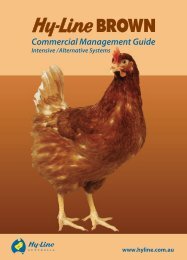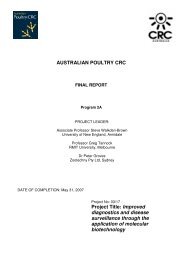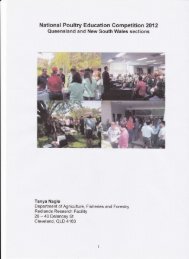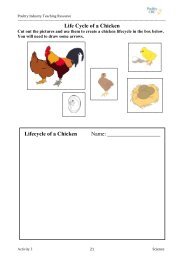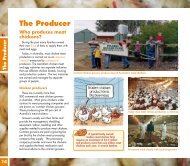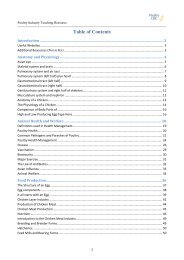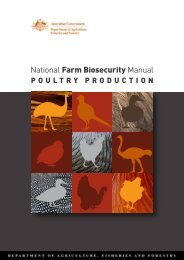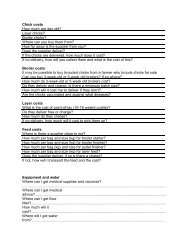Create successful ePaper yourself
Turn your PDF publications into a flip-book with our unique Google optimized e-Paper software.
approximately 126m. The experiment was conducted in autumn from March to April, 2006, withaverage daily temperatures ranging from 13.6˚C to 28.1˚C in March, and from 9.4˚C to 22.9˚C inApril (Australian Bureau of Meteorology, 2006).The testing facility was a modified commercial grow-out shed, originally capable of holdingapproximately 30,000 broilers under contemporary stocking density legislation. Within the shed, 96pens (5.28m 2 ) capable of holding 90 birds at 2.1 kg per bird (maximum of 36 kg.m -2 stocking density),were available for use for the experiment, but only 84 pens were used. The shed was tunnelventilated, with the temperature controlled from the front annex of the shed via an electronic controlpanel, set to decrease the shed temperature from 32˚C at one day of age, down to 21˚C at 21 days ofage, and this temperature was maintained thereafter. The shed was illuminated using 8 W fluorescentlight globes, providing between 12 and 16 Lux at shed floor level throughout the experimental period.2.5.1 Hypotheses and aimsBased on the findings of the previous experiments, it was hypothesised that the level of grainprocessing and the means by which the grain was processed would influence the performance and gutphysiology of the birds. Furthermore, it was postulated that the birds receiving a coarse wheat particlewould perform better than birds receiving a fine particle, and that birds fed rolled grain would have alower feed conversion ratio, than birds fed hammer-milled grain of an equivalent particle size. Theexpected differences in performance between particle size and milling type groups of treatments, washypothesised to be due to differences in enteric microbial status, digesta pH, and starch digestibility,brought about by a more developed and more efficient digestive tract.The experimental aims were to determine if, under commercial conditions with birds placed on litter,wheat particle size and milling type would affect performance, gut development, and enteric microbialstatus of male and female broilers.2.5.2 Bird husbandryTwelve single pen replicates of seven dietary treatments were randomly allocated to 84 pens, with 90,one day old Ross 308 broilers placed per pen replicate (7560 birds total). Treatments were allocated topens in a randomised block design. The seven treatments were as follows: HM3.2A - Commercialgrind (hammer-mill 3.2mm screen) with IFA; HM3.2 - Commercial grind (hammer-mill 3.2mmscreen); HM35 - Hammer-mill intermediate grind (no screen, 35% feed rate); HM55 - Hammer-millcoarse (no screen, 55% feed rate); RM35 - Roller-mill intermediate (0.3 mm roller spacing, maximumpressure, minimum feed rate); RM55 - Roller-mill coarse (0.3 mm roller spacing, maximum pressure,maximum feed rate), and WW - Whole wheat, passed through roller mill with minimum pressure andmaximum flow rate (most grains with stress fissures).Birds were placed in groups of 90 into each pen and fed a commercially formulated, crumbled, prestarterdiet, without an IFA or coccidiostat, until 6 days of age. The birds were then started on theirrespective experimental diets in a coarse crumble formulated as per a commercial starter diet (from 7to 17 days of age). The method and degree of wheat processing for the starter, grower and finisherdiets was maintained for each treatment and was conducted using commercially available feedprocessing equipment. Birds were fed a grower and finisher diet, from approximately 18-35 days ofage and 36-43 days of age respectively, depending on individual pen feed consumption. All feedswere fed to the birds on an ad libitum basis. Water was supplied to each pen via common drinkinglines from day one to day 43.Samples for analyses were taken at 21 and 41 days of age. Birds used for sampling - one per pen –were humanely euthanazed using cervical dislocation. Birds not used for dissections were processedat 43 days of age at Bartter‟s commercial processing plant, whereupon final bird weights were takenfor performance calculations.12



